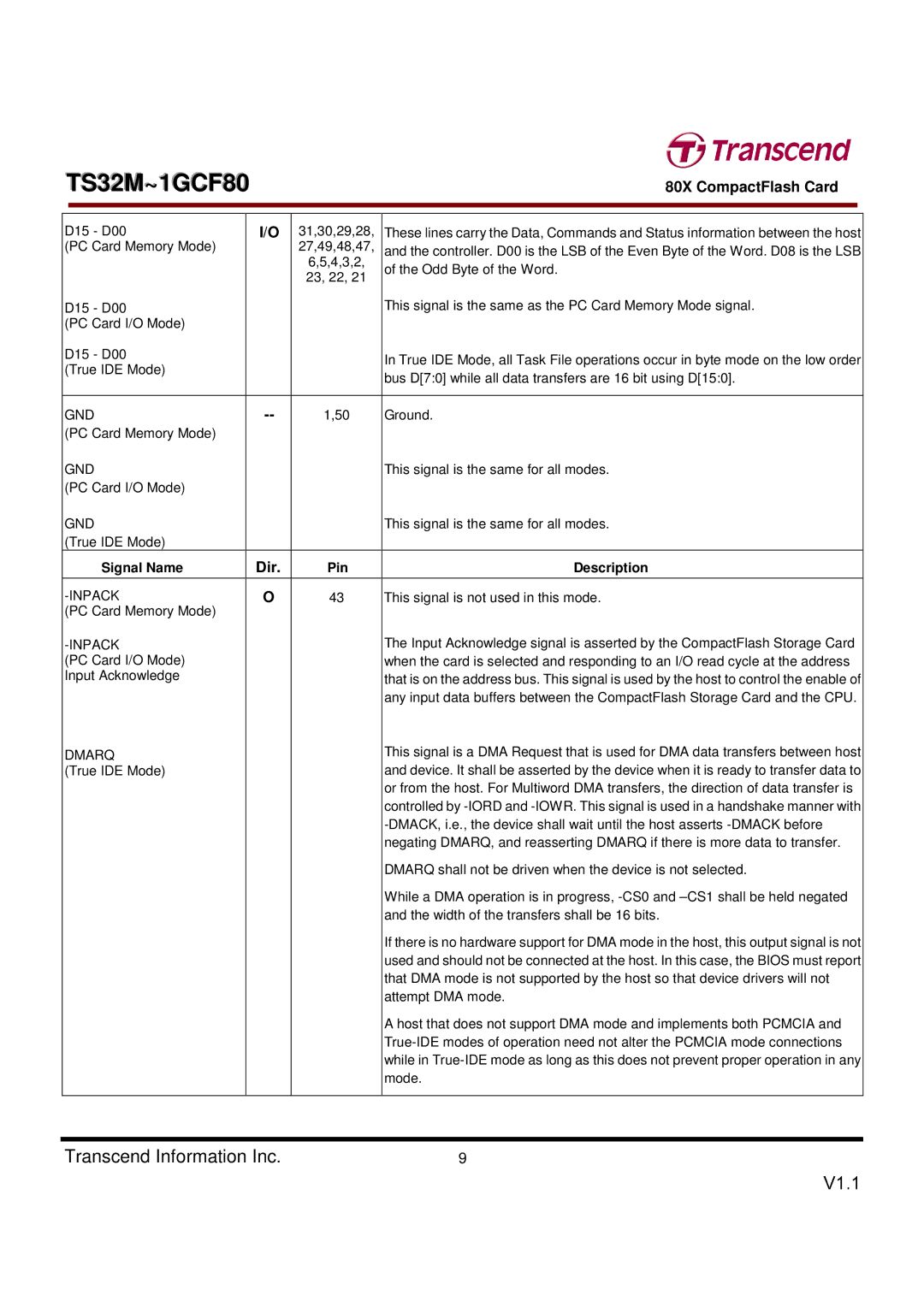
TS32M~1GCF80 |
|
| 80X CompactFlash Card | |||
|
|
|
|
|
|
|
|
|
|
|
| ||
D15 - D00 |
| I/O | 31,30,29,28, | These lines carry the Data, Commands and Status information between the host | ||
(PC Card Memory Mode) |
|
| 27,49,48,47, | and the controller. D00 is the LSB of the Even Byte of the Word. D08 is the LSB | ||
|
|
|
| 6,5,4,3,2, | of the Odd Byte of the Word. | |
|
|
|
| 23, 22, 21 | ||
|
|
|
|
|
| |
D15 - D00 |
|
|
| This signal is the same as the PC Card Memory Mode signal. | ||
(PC Card I/O Mode) |
|
|
|
|
| |
D15 - D00 |
|
|
| In True IDE Mode, all Task File operations occur in byte mode on the low order | ||
(True IDE Mode) |
|
|
| |||
|
|
| bus D[7:0] while all data transfers are 16 bit using D[15:0]. | |||
|
|
|
|
| ||
|
|
|
|
| ||
GND |
| 1,50 | Ground. | |||
(PC Card Memory Mode) |
|
|
|
|
| |
GND |
|
|
| This signal is the same for all modes. | ||
(PC Card I/O Mode) |
|
|
|
|
| |
GND |
|
|
| This signal is the same for all modes. | ||
(True IDE Mode) |
|
|
|
|
| |
| Signal Name |
| Dir. | Pin | Description | |
|
|
|
|
| ||
| O | 43 | This signal is not used in this mode. | |||
(PC Card Memory Mode) |
|
|
|
|
| |
|
|
| The Input Acknowledge signal is asserted by the CompactFlash Storage Card | |||
(PC Card I/O Mode) |
|
|
| when the card is selected and responding to an I/O read cycle at the address | ||
Input Acknowledge |
|
|
| that is on the address bus. This signal is used by the host to control the enable of | ||
|
|
|
|
| ||
|
|
|
|
| any input data buffers between the CompactFlash Storage Card and the CPU. | |
DMARQ |
|
|
| This signal is a DMA Request that is used for DMA data transfers between host | ||
|
|
|
|
| ||
(True IDE Mode) |
|
|
| and device. It shall be asserted by the device when it is ready to transfer data to | ||
|
|
|
|
| or from the host. For Multiword DMA transfers, the direction of data transfer is | |
|
|
|
|
| controlled by | |
|
|
|
|
| ||
|
|
|
|
| negating DMARQ, and reasserting DMARQ if there is more data to transfer. | |
|
|
|
|
| DMARQ shall not be driven when the device is not selected. | |
|
|
|
|
| While a DMA operation is in progress, | |
|
|
|
|
| and the width of the transfers shall be 16 bits. | |
|
|
|
|
| If there is no hardware support for DMA mode in the host, this output signal is not | |
|
|
|
|
| used and should not be connected at the host. In this case, the BIOS must report | |
|
|
|
|
| that DMA mode is not supported by the host so that device drivers will not | |
|
|
|
|
| attempt DMA mode. | |
|
|
|
|
| A host that does not support DMA mode and implements both PCMCIA and | |
|
|
|
|
| ||
|
|
|
|
| while in | |
|
|
|
|
| mode. | |
|
|
|
|
| ||
|
|
|
|
|
|
|
Transcend Information Inc. |
| 9 |
| |||
|
|
|
|
| V1.1 | |
